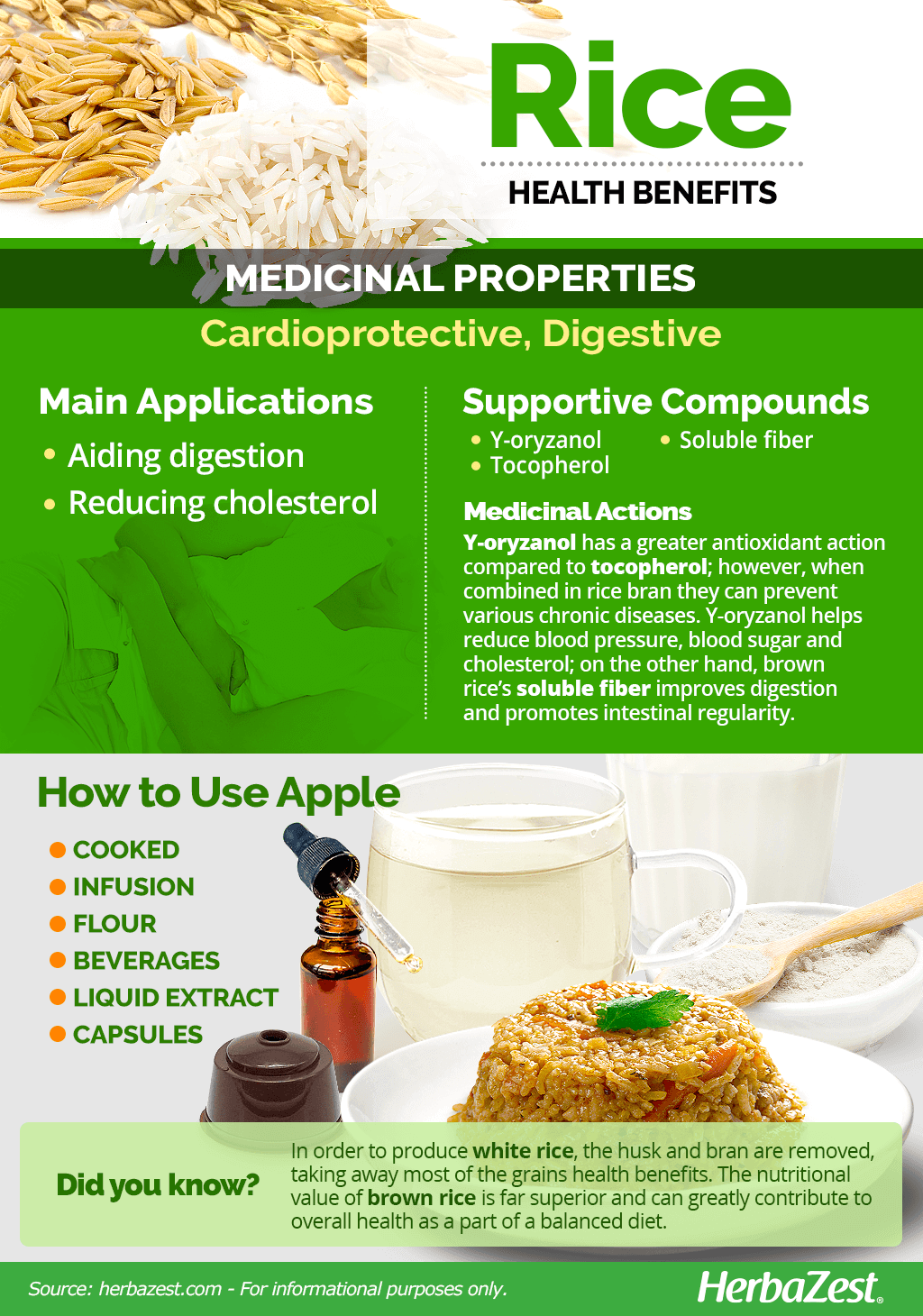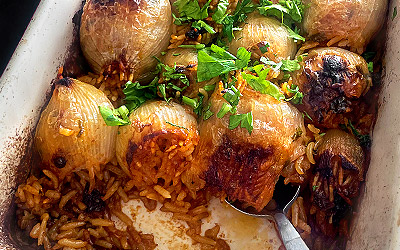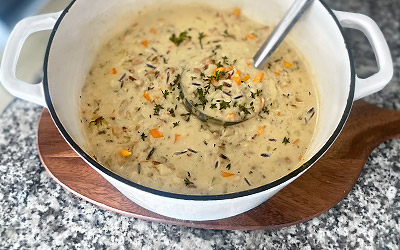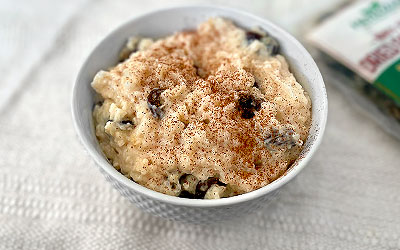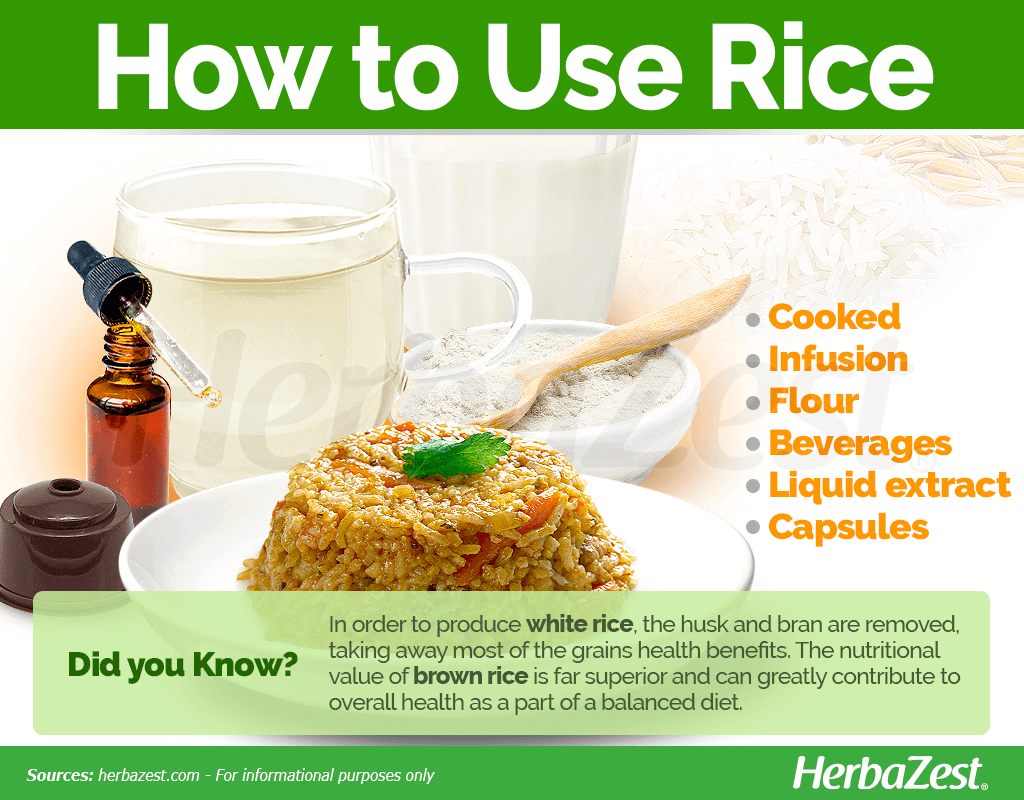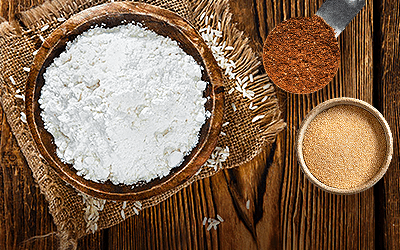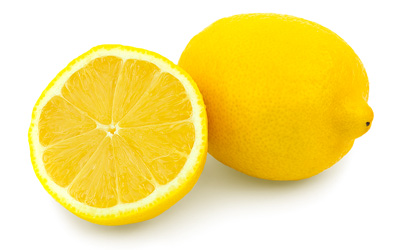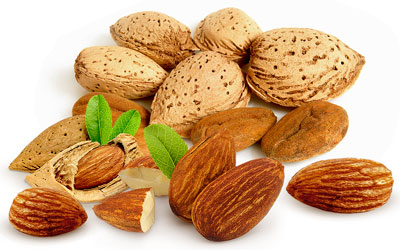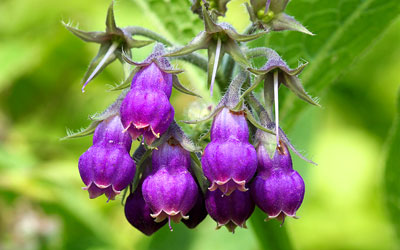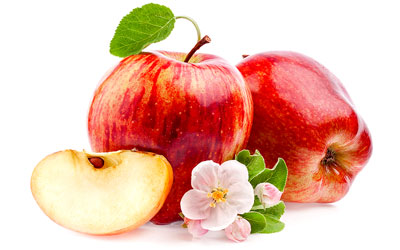Native to China, rice has been cultivated and consumed in an array of forms for millennia. Although rice is generally associated with traditional Asian cuisine, it is widely consumed in almost every country around the world. Because of the well-known slender physique of Eastern Asians, many people believe that a rice-rich diet is the answer to preventing obesity and its related health conditions in the West.
Rice Medicinal Properties
Health Benefits of Rice
Particularly in Asia, rice has been used in traditional medicine as well as a foodstuff. The wealth of remedial uses of rice is interesting and varied, and many modern herbalists claim that rice is valuable for treating many specific ailments. These claims - and the fact that those who consume a diet high in rice are generally slender - have attracted the attention of dieticians and scientists. Consequently, many studies have been carried out in order to try to understand if and how rice can be beneficial to human health. So far, these are the main proven benefits of rice:
Aiding digestion. Brown rice still has the husk, bran, and germ intact, which are the components that possess a high fiber content. Fiber is used by the body to encourage healthy digestion and consequently bowel movements.
- Reducing cholesterol. Some of the antioxidant compounds found in rice can lower cholesterol levels and, therefore, promote cardiovascular health.
The secondary benefits of rice include:
Supporting the immune system. The vitamins and minerals found in rice include various antioxidants. These are helpful for maintaining a well-functioning immune system that can fend off sicknesses, such as the common cold.
Improving metabolism. Rice - particularly brown (i.e., wholegrain) - contains vitamins and minerals that can increase the efficiency of internal organs, including those of the digestive system.
Some of the more unorthodox remedies that have used rice include those for treating dysentery, hemorrhoids, ulcers, and topical skin afflictions. There may be some merit to these claims because of the chemical compounds found in rice; however, further scientific research is required before they can be fully quantified.
How It Works
Most of rice properties are concentrated in the seed coat, or rice bran, which contains important nutrients, mainly oryzanols, tocopherols, tocotrienols, phytosterols, fixed oil, proteins, carbohydrates, and dietary fibers like beta-glucan, pectin, and gum.
Gamma oryzanol (γ-oryzanol) has been found to have a higher antioxidant action in comparison to other rice compounds, such as tocopherol, a form of vitamin E. However, when combined, these phytochemicals in rice bran can prevent a variety of chronic diseases. γ-oryzanol has been found to help prevent metabolic syndrome by reducing blood pressure, blood sugar, and cholesterol. The consequence of these actions is improved cardiovascular health and a more efficient metabolism, including a faster processing of foods.
γ-oryzanol has also been shown to inhibit liver fat accumulation and inflammation. It can significantly reduce the amount of triglycerides and down-regulate expression of stearoyl coenzyme-A desaturase-1, an enzyme that plays an important role in the formation of monounsaturated fatty acids (MUFA), which might enhance γ-oryzanol's hepatoprotective effects.
The insoluble fiber in wholegrain rice attracts water into the digestive system, softening the stools and stimulating bowel movements, thus helping relieve constipation.
Depending on the variety of rice, the long list of nutrients include antioxidant compounds, such as phenolic acids, flavonoids, and anthocyanins, to name a few. Antioxidants support a strong immune system; they are necessary for cellular regeneration; and they are essential for fighting diseases and external pollutants, such as those caused by smoking or a poor diet.
Red yeast rice is said to be able to help lower cholesterol. This variety has been developed in China from the cultivation of rice with a specific type of yeast (Monascus purpureus). The final product contains compounds such as monacolin K, which has been used in drugs prescribed for lowering cholesterol. The mechanics of this compound in the body are yet to be fully understood; however, in China, this kind of rice is often suggested to those who have high cholesterol.
Other herbs with immunoprotective benefits are cabbage and tea plant (especially green tea), whereas apricot and spinach have digestive properties, and both olive and tomato support cardiovascular health.
Rice Side Effects
Rice and rice-based health preparations are deemed safe for general consumption, as long as they are consumed as part of a balanced diet. Pregnant or breastfeeding women should consult their physician before using rice supplements. Those who suffer from an allergy to rice should also avoid contact.
Rice Cautions
One of the main cautions concerning rice is reheating it after it has been cooked and left to cool. Rice can contain spores of a bacterium known as Bacillus cereus, which can survive cooking. The spores are dormant, but can develop into active bacteria if left at room temperature after cooking. If ingested, this bacteria can cause food poisoning, the symptoms of which can include vomiting and diarrhea.
Another - less common - problem is the presence of arsenic in rice. This is found more in rice produced in India and depends on the environment in which the plant is cultivated. Arsenic naturally occurs in soil and water in varying concentrations in different regions. It can be absorbed by plants and cause chromosomal damage in humans who consume the affected produce. There are screening processes in place to avoid contaminated rice being exported; however, the concern is still widespread, especially in the third world countries.
- Medicinal action Cardioprotective, Digestive
- Key constituents γ-Oryzanol
- Ways to use Capsules, Hot infusions/tisanes, Food, Tincture
- Medicinal rating (4) Very useful plant
- Safety ranking Safe
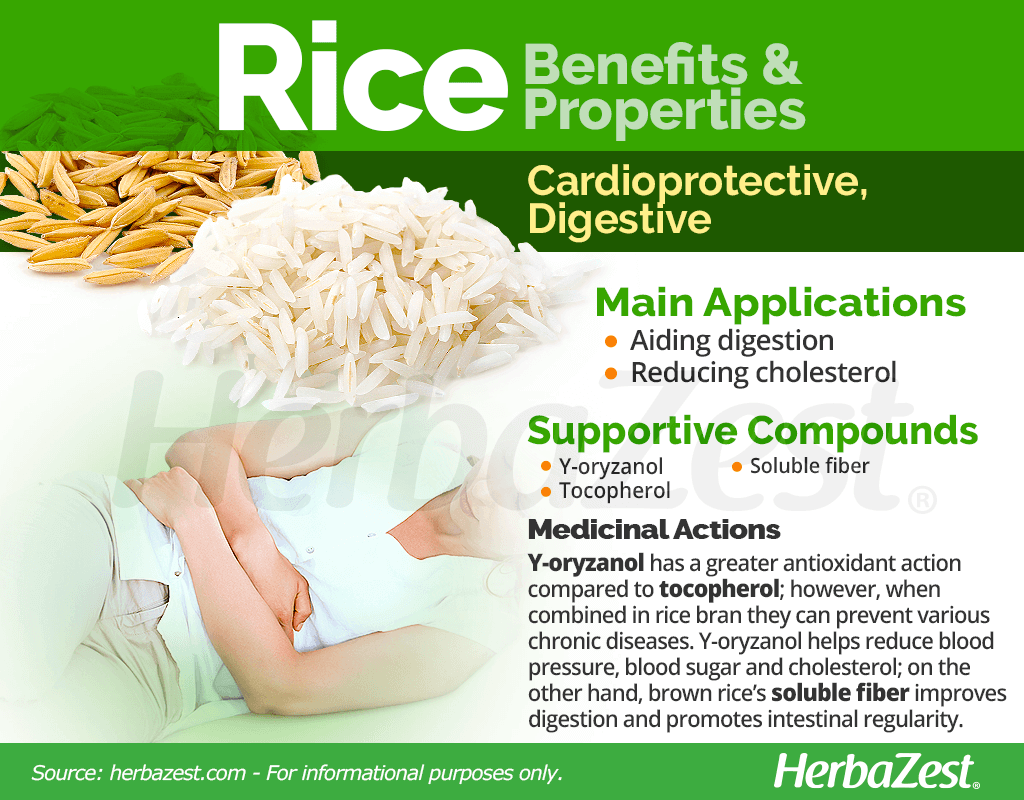
Rice Nutrition
In order to produce white rice, the husk and bran are removed, taking away most of the grains health benefits.
Although white rice is widely preferred worldwide, it is the product of a process that strips the grains off their exterior husk and their seed coat, a natural layer known as rice bran, where most nutrients are concentrated, in order to "polish" them. The nutritional value of brown rice is far superior and can greatly contribute to overall health as part of a balanced diet.
White rice is usually enriched with some of the nutrients it loses during its production, mainly vitamins B1 (thiamin) and B9 (folate), both of which are important for fetal development, immunity support, and red blood cell production. On the other hand, brown rice naturally offers great amounts of manganese, which promotes bone regeneration by improving calcium absorption, as well as good levels of copper and selenium for healthy blood vessels and cell damage prevention.
The nutritional value of rice as a wholegrain is rounded by good levels of vitamin B3 (niacin) as well as adequate amounts of other B-complex vitamins and minerals such as magnesium, phosphorus, and zinc.
186 grams of cooked white rice provide 242 calories and 2% of the recommended daily value (DV) for dietary fiber, whereas the same amount of cooked brown rice offers 207 calories and 13% DV of fiber.
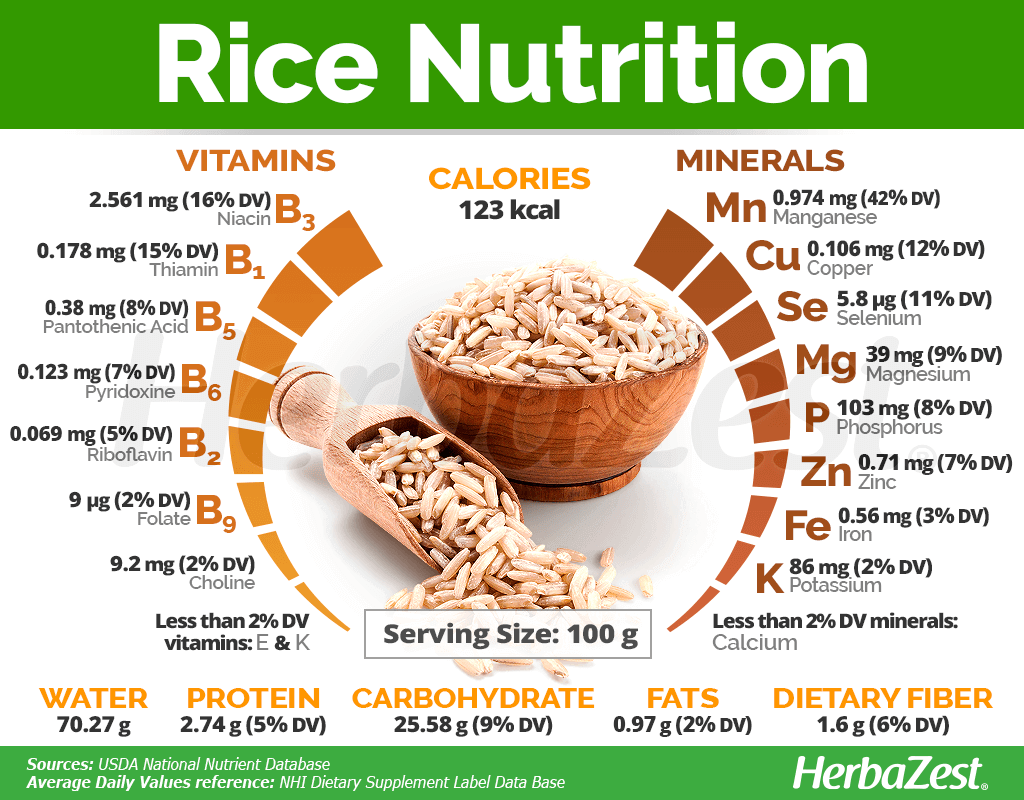
How to Consume Rice
The culinary uses of rice amount to an extensive list, with various traditional Chinese medicine herbal preparations found around the world. Many of these remedies are still valued today, and due to a significant number of Asian inhabitants in many countries, they have risen in popularity and are used by advocates of natural medicine everywhere.
Rice has been extensively cultivated, meaning there is a wide range of types available. These include long-grain brown rice, white rice, basmati, sticky, red, jasmine, and black rice, to name a few. These are all easy to cook by simply boiling in water and can be used in both sweet and savory dishes.
Natural Forms
Cooked. Rice is a staple food, served as a main component in many savory and sweet dishes, from stir-fries, paella, sushi, and risotto to granola bars, cookies, and rice cakes.
Infusion. This is particularly popular in Japan, where it is known as genmaicha. It is made by infusing roasted brown rice with hot water and tea leaves for flavor. It is a favored way of consuming rice for its antioxidants.
Flour. It is made by milling raw rice into a very fine powder. Since it is gluten free, rice flour can be a worthy substitution for wheat flour as a thickening agent for sauces and soups as well as for making noodles and pancakes.
Beverages. Rice drinks can be prepared at home (like Mexican horchata) or bought at the store since rice milk is widely available and usually comes fortified with vitamins and minerals. However, care should be taken to avoid added sugars.
Herbal Remedies & Supplements
Liquid extract. Red yeast rice extract has been traditionally used in Chinese medicine to lower cholesterol; however, this claim is yet to be corroborated by science.
Capsules.The most common rice supplements are made with the aforementioned red yeast rice. This is particularly marketed for lowering cholesterol and, therefore, promoting heart health.
- Edible parts Seed
- Edible uses Beverage, Oil
- Taste Earthy, Mild
Growing
Rice can be grown in warm climates all over the world, but it requires considerable human attention and maintenance. If its preferred natural environment is not available, it is possible to cultivate rice indoors, but generally on a much smaller scale.
Growing Guidelines
Rice plants require a warm temperature of at least 70°F (21°C) throughout growth; therefore, a position in full sun is ideal if planting outside. It will still grow indoors if subjected to these temperatures.
Seeds should be soaked in water for around 24 hours before planting in order to stimulate germination.
Plant the seeds around 4 inches (10 cm) apart to prevent crowding.
Seeds should be planted in very wet - even flooded - soil. It is important to apply generous amounts of water at all stages of development; in Asia, rice is grown in paddy fields, which are kept in a swamp-like state.
A layer of mulch above the soil can be used to help ensure moisture entrapment.
The plants can reach around 15 inches (38 cm) in height and are ready to be harvested after around three or four months.
In colder areas, it is possible to cultivate rice indoors in much the same way; however, the plants need to be in a container that is kept in a warm area, such as a sun room.
More detailed information about growing rice can be found in the herb garden section.
- Harvested parts Seeds
- Light requirements Full sun
- Soil Flooded
- Soil pH 5.1 – 5.5 (Strongly acidic), 5.6 – 6.0 (Moderately acidic), 6.1 – 6.5 (Slightly acidic), 6.6 – 7.3 (Neutral)
- Growing habitat Warm climates
- Pre-germination seed treatment Soaking
- Plant spacing average 0.1 m (0.30 ft)
- Growing time 3 - 4 months
- Potential diseases Downy mildew, Stem rots
Additional Information
Plant Biology
Rice (Oryza sativa) is considered a type of grass, and the most common species is known as XXXX. It grows in aquatic regions, such as deep waters, where it can grow to reach lengths in excess of 16 feet (5 m). The stem grows upright, and a collection of long leaves develops from it. A branch possessing seeds, which are the individual grains of rice, will also grow from the stem. The grains are usually between 0.22 - 0.3 inches (5.5 -7.5 mm) long and are made up of an inner seed, then two layers of papery husks. The inedible outer husk is removed before consuming the rice.
Classification
Oryza sativa is part of the Poaceae family, which is comprised of plants collectively known as grasses, including cereals and bamboo. This group contains over 10,000 species across 750 genera. Some of the most well-known members of this family, aside from rice, include barley (Hordeum vulgare), lemongrass (Cymbopogon citratus), millet (Pennisetum glaucum), oat (Avena sativa), sugarcane (Saccharum officinarum), and wheat (Triticum aestivum).
Subspecies and Cultivars of Rice
Rice is part of the genus Oryza, which comprises 18 species. There are two subspecies of O. sativa: O. sativa subsp. indica, known as Indian or red rice, which has a high amylose content - making it drier - and O. sativa subsp. japonica, or black rice, which has a low amylose content and is, therefore, stickier when cooked.
From those subspecies, producers all over the world have developed a vast number of rice cultivars, which have been designed to suit the needs of consumers. Asian indica cultivars represent about 80% of the global rice production, while japonica cultivars are mostly grown in temperate areas of northeastern Asia, Europe, the U.S. (California), and Australia.
Historical Information
Recent studies have revealed that both indica and japonica rice was present in the Pearl River valley region of China, around 10,000 years ago. Fossilized tools for farming rice have also been discovered, which date back to around 8,000 years ago. Rice is believed to have been introduced to Europe during the Greek or Roman era. It was then brought to the Americas in the 17th century by European explorers and settlers. The earliest known appearance of rice in the U.S. was in 1686 in South Carolina, when it was cultivated by British colonist Dr. Henry Woodward.
Economic Data
Around 700 million tons of rice are produced every year, but the majority of it is consumed in the country that has produced it. The major producer of rice in the world is China, followed by India, Indonesia, Bangladesh, Vietnam, Thailand, Myanmar, Philippines, Brazil, Japan, USA, Pakistan, and the Republic of Korea.
Between 2000 and 2010, the top importers of rice were the European Union, Indonesia, Iran, Nigeria, and the Philippines; these accounted for 27% of global imports. Today, there are plans to increase the production of rice in sub-Saharan Africa so that they do not need to rely on imports. If this can be achieved, it could be an important factor in reducing the region's malnutrition and poverty crisis.
Almost half of the world's population relies on rice as a staple food, with 90% of it being the Asian countries.
Popular Beliefs
Rice has long been revered in southeast Asia, so much so that there is a goddess of rice in Indonesian culture known as Dewi Sri. She is believed to have influence over the cultivation of rice and is also thought to bring wealth and prosperity in general.
Other Uses
Oil. Oil can be extracted from the outer husks of rice. It is known to have a high smoking point of 450°F (232°C), which makes it suitable for cooking. Its mild, nutty flavor is considered pleasant for stir-fries and other Asian meals.
Alcohol. Rice starch can be fermented to make wine, whiskey, sake, and other liqueurs. These are especially popular in China and Japan.
Vinegar. Sometimes referred to as rice wine vinegar, it is made by fermenting rice, but not to the extent that it becomes alcoholic. It is used in Asian cooking.
Paper. Rice straws and husks are used to make a fairly strong and yet translucent paper, which is edible and often used for wrapping confections and for other culinary purposes.
The rice plant has also been used as a fertilizer and as animal feed.
Almost half of the world's population depends on rice as the main component of their diet. It can provide a significant portion of the daily vitamins and minerals required by the human body, but it is recommended that rice is enjoyed in conjunction with fresh fruits, vegetables, and protein as part of a balanced diet.
- Other uses Alcohol, Animal feed, Paper, Fiber, Fertilizer
Sources
- Columbia University, What’s in Your Rice? A Look at Where Rice in the U.S. Comes from
- Cornell University, Gannett Health Services, Fiber, Digestion, and Health
- International Journal of Molecular Sciences, Antioxidant Activity of γ-Oryzanol: A Complex Network of Interactions, 2016
- Journal of Scientific and Innovative Research, Nonpolar chemical constituents from the Oryza sativa L. bran, 2014
- National Health Service, Can reheating rice cause food poisoning?
- National Library of Medicine, Rice antioxidants: phenolic acids, flavonoids, anthocyanins, proanthocyanins, tocopherols, tocotrienols, y-oryzanol, and phytic acid
- Open Access Scientific Reports, Effects of Ferulic Acid and γ-Oryzanol on High-Fat and High-Fructose Diet-Induced Metabolic Syndrome in Rats, 2015
- Purdue University, Oryza sativa L.
- Rice: Origin, History, Technology, and Production
- Ricepedia
- Trends in Food Science & Technology, Therapeutic properties of rice constituents and derivative (Oryza sativa L.): A review update, 2014
- Kew Royal Botanic Gardens, Oryza sativa (rice)
- University of Maryland Medical Center, Red yeast rice
